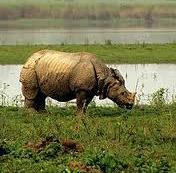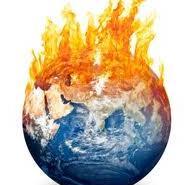The Ministry of Environment and Forests (MoEF) came out with new guidelines to create eco-sensitive zones (ESZs) around Protected Areas to prevent ecological damage caused due to developmental activities around National Parks and Wildlife Sanctuaries in 2011.
Eco-Sensitive Zones (ESZs) around Protected Areas
31 Jul 2014
By
Admin
Related Posts with thumbnails for bloggerblogger widgets
Continue reading..
Seagrass can fight against climate change
20 Aug 2013
By
Admin
Seagrass can fight against climate change
Latest studies revealed that Seagrass can be crucial in the battle against climate change as this humble plant is 35 times more efficient at locking up, or 'sequestering' carbon than rainforests. These unusual marine flowering plants are called seagrasses because in many species the leaves are long and narrow. Seagrass often grow in large "meadows" which look like grassland. In other words many of the species of seagrasses superficially resemble terrestrial grasses.
Related Posts with thumbnails for bloggerblogger widgets
Continue reading..
1.General Knowledge for UPSC, Banking and PSC Examinations
16 May 2013
By
Admin
Protection of Mangrove Forests
 Zoological Survey of India has been undertaking studies on the serious threat to coral colonies only of Palk Bay continuously for more than 10 years. Studies confirm that there is reduction in the live coral cover and increase in rubbles, macro-algae and calcareous algae which indicate continuing degradation of these reefs.
The Government seeks to protect, sustain and augment mangroves and coral reef in the country by both regulatory and promotional measures. Under the regulatory measures, the Coastal Regulation Zone (CRZ) Notification (2011) and the Island Protection Zone (IPZ) Notification 2011 regulates the development activities along the Sea coast and tidal influenced water bodies.
Zoological Survey of India has been undertaking studies on the serious threat to coral colonies only of Palk Bay continuously for more than 10 years. Studies confirm that there is reduction in the live coral cover and increase in rubbles, macro-algae and calcareous algae which indicate continuing degradation of these reefs.
The Government seeks to protect, sustain and augment mangroves and coral reef in the country by both regulatory and promotional measures. Under the regulatory measures, the Coastal Regulation Zone (CRZ) Notification (2011) and the Island Protection Zone (IPZ) Notification 2011 regulates the development activities along the Sea coast and tidal influenced water bodies.
Related Posts with thumbnails for bloggerblogger widgets
Continue reading..
General issues on Environmental ecology : Waste and Toxins
27 Mar 2012
By
Admin
 Leachate
Leachate
Leachate is any liquid material that drains from land or stockpiled material and contains significantly elevated concentrations of undesirable material derived from the material that it has passed through. Once in contact with decomposing solid waste, the percolating water becomes contaminated and if it then flows out of the waste material it is termed leachate. Additional leachate volume is produced during this decomposition of carbonaceous material producing a wide range of other materials including methane, carbon dioxide,ammonia and a complex mixture of organic acids etc.
Related Posts with thumbnails for bloggerblogger widgets
Continue reading..
General issues on Environmental ecology : Fossil Fuels
By
Admin
Petroleum and natural gas are fuels formed by the anaerobic decomposition of remains of organisms including phytoplankton and zooplankton that settled to the sea or lake bottom in large quantities under anoxic conditions, millions of years ago and sometimes exceeds 650 million years. Over geological time, this organic matter, mixed with mud, got buried under heavy layers of sediment. The resulting high levels of heat and pressure caused the organic matter to chemically alter, first into a waxy material known as kerogen which is found in oil shales, and then with more heat into liquid and gaseous hydrocarbons in a process known as catagenesis. Fossil fuels contain high percentages of carbon and include coal, petroleum, and natural gas. Currenlty, primary sources of energy consisted of petroleum 36.0%, coal 27.4%, natural gas 23.0%, amounting to an 86.4% share for fossil fuels in primary energy consumption in the world. Non-fossil sources included hydroelectric 6.3%, nuclear 8.5%, and others (geothermal, solar, tide, wind, wood, waste) amounting to 0.9% only. World energy consumption was growing about 2.3% per year.
Related Posts with thumbnails for bloggerblogger widgets
Continue reading..
General issues on Environmental ecology : Greenhouse Gases
26 Mar 2012
By
Admin
The greenhouse effect is the process by which absorption and emission of infrared radiation by gases in the atmosphere warm a planet's lower atmosphere and surface. Greenhouse gases are those that can absorb and emit infrared radiation. Greenhouse gases greatly affect the temperature of the Earth; without them, Earth's surface would be on average about 33 °C colder than at present. The major greenhouse gases are water vapor, which causes about 36–70% of the greenhouse effect; carbon dioxide (CO2), which causes 9–26%; methane (CH4), which causes 4–9%; and ozone (O3), which causes 3–7%.
Related Posts with thumbnails for bloggerblogger widgets
Continue reading..
General issues on Environmental ecology : Pollution
By
Admin
Pollution is the introduction of contaminants into a natural environment that causes instability, harm or discomfort to the ecosystem. A point source of pollution is a single identifiable source of air, water, thermal, noise or light pollution. Some examples are 1. Water pollution from an oil refinery wastewater discharge outlet, 2.Noise pollution from a jet engine, 3. Light pollution from an intrusive street light etc. Nonpoint source (NPS) pollution refers to both water and air pollution from diffuse sources. Although these pollutants have originated from a point source, the long-range transport ability and multiple sources of the pollutant make it a nonpoint source of pollution. Runoff of soil and fertilizer during a rain storm can be considered as a Nonpoint source (NPS) pollution.
Related Posts with thumbnails for bloggerblogger widgets
Continue reading..
General issues on Environmental ecology : Global warming
By
Admin
Global warming refers to the rising average temperature of Earth's atmosphere and oceans, which began to increase in the late 19th century and is projected to continue rising. Since the early 20th century, Earth's average surface temperature has increased by about 0.8 °C, with about two thirds of the increase occurring since 1980.Most of it is caused by increasing concentrations of greenhouse gases produced by human activities such as deforestation and burning fossil fuels. Recently World Meteorological Organization Secretary-General Michel Jarraud warned that the consequences of global warming could be permanent. "The world is warming because of human activities and this is resulting in far-reaching and potentially irreversible impact on our Earth, atmosphere and oceans," he said.
Related Posts with thumbnails for bloggerblogger widgets
Continue reading..
Global Dimming | Causes and Impact
5 Mar 2012
By
Admin
 Global Dimming
Global Dimming
Global dimming is the gradual reduction in the amount of global direct irradiance at the Earth's surface. It is thought that global dimming is probably due to the increased presence of aerosol particles in the atmosphere caused by human action. Aerosols and other particulates absorb solar energy and reflect sunlight back into space. Increased pollution causes more particulates and thereby creates clouds consisting of a greater number of smaller droplets (that is, the same amount of water is spread over more droplets). The smaller droplets make clouds more reflective, so that more incoming sunlight is reflected back into space and less reaches the Earth's surface. Al first global dimming sounds like an ironic saviour for climatic changes including global warming.However, now its believed that global dimming has caused severe drought in several parts of the world as the northern hemisphere oceans were not warmed enough to form rainfall.
Related Posts with thumbnails for bloggerblogger widgets
Continue reading..
Endosulfan in India | Endosulfan Ban in India
5 Dec 2011
By
Admin
Endosulfan is an insecticide/pesticide that is being phased out globally. It is a highly toxic, ubiquitous environmental pollutant that causes long-term harm to humans and wildlife. It is widely considered to be a Persistent Organic Pollutant (POP) and is readily absorbed by stomach, lungs and through the skin. Endosulfan became a highly controversial agrichemical due to its acute toxicity, potential for bioaccumulation, and role as an endocrine disruptor. Endocrine disruptors are chemicals that interfere with endocrine (or hormone system) in animals, including humans. These disruptions can cause cancerous tumors, birth defects, and other developmental disorders. Because of its threats to human health and the environment, a global ban on the manufacture and use of endosulfan was negotiated under the Stockholm Convention in April 2011. The ban will take effect in mid 2012, with certain uses exempted for 5 additional years. More than 80 countries had already banned it or announced phase outs by the time the Stockholm Convention ban was agreed upon.
Related Posts with thumbnails for bloggerblogger widgets
Continue reading..
UNFCCC and Kyoto Protocol Explained
24 Oct 2011
By
Admin
 The United Nations Framework Convention on Climate Change (UNFCCC or FCCC) is an international environmental treaty came into effect at the UN Conference on Environment and Development (UNCED). The convention is informally known as the Earth Summit and was held in Rio de Janeiro in 1992. The aim of the treaty is to stabilize greenhouse gas concentrations in the atmosphere at a level that would prevent dangerous anthropogenic interference with the climate system. The treaty itself set no mandatory limits on greenhouse gas emissions for individual countries and contains no enforcement mechanisms. So the treaty is considered as legally non-binding. But the treaty provides for updates (called "protocols") that would set mandatory emission limits. The first and principal update is the Kyoto Protocol. The Protocol was initially adopted in 1997 in Kyoto, Japan, and entered into force in 2005. As of September 2011, 191 states have signed and ratified the protocol. A notable exception is United States, which had signed, but not ready to ratify it.
The United Nations Framework Convention on Climate Change (UNFCCC or FCCC) is an international environmental treaty came into effect at the UN Conference on Environment and Development (UNCED). The convention is informally known as the Earth Summit and was held in Rio de Janeiro in 1992. The aim of the treaty is to stabilize greenhouse gas concentrations in the atmosphere at a level that would prevent dangerous anthropogenic interference with the climate system. The treaty itself set no mandatory limits on greenhouse gas emissions for individual countries and contains no enforcement mechanisms. So the treaty is considered as legally non-binding. But the treaty provides for updates (called "protocols") that would set mandatory emission limits. The first and principal update is the Kyoto Protocol. The Protocol was initially adopted in 1997 in Kyoto, Japan, and entered into force in 2005. As of September 2011, 191 states have signed and ratified the protocol. A notable exception is United States, which had signed, but not ready to ratify it.
Related Posts with thumbnails for bloggerblogger widgets
Continue reading..
Urban Heat Island | Causes and Effects of Urban Heat Island
22 Oct 2011
By
Admin
 An urban heat island (UHI) is a urban area which is significantly warmer than its surrounding rural areas. The temperature difference usually is larger at night than during the day, and is most apparent when winds are weak. Seasonally, UHI is seen during both summer and winter. By virtue of their high heat capacities, urban surfaces act as a giant reservoir of heat energy. For example, concrete can hold roughly 2,000 times as much heat as an equivalent volume of air. Latest studies shows that UHI is one among the main reasons for Global warming. The rising columns of warm air in urban areas are commonly called as "urban thermal plume". The temperature difference between urban areas and the surrounding rural areas can be as much as 5 degrees Celsius
An urban heat island (UHI) is a urban area which is significantly warmer than its surrounding rural areas. The temperature difference usually is larger at night than during the day, and is most apparent when winds are weak. Seasonally, UHI is seen during both summer and winter. By virtue of their high heat capacities, urban surfaces act as a giant reservoir of heat energy. For example, concrete can hold roughly 2,000 times as much heat as an equivalent volume of air. Latest studies shows that UHI is one among the main reasons for Global warming. The rising columns of warm air in urban areas are commonly called as "urban thermal plume". The temperature difference between urban areas and the surrounding rural areas can be as much as 5 degrees Celsius
Related Posts with thumbnails for bloggerblogger widgets
Continue reading..
Kaziranga National Park of India
12 Oct 2011
By
Admin
 Kaziranga National Park is a national park in the state of Assam, India. A World Heritage Site, the park hosts two-thirds of the world's Great One-horned Rhinoceroses. Kaziranga boasts the highest density of tigers among protected areas in the world and was declared a Tiger Reserve in 2006. The park is home to large breeding populations of elephants, wild water buffalo, and swamp deer. Kaziranga is recognized as an Important Bird Area by Birdlife International for conservation of avifaunal species. Kaziranga is a vast expanse of tall elephant grass, marshland, and dense tropical moist broadleaf forests, crisscrossed by four major rivers, including the Brahmaputra, and the park includes numerous small bodies of water. The park celebrated its centennial in 2005 after its establishment in 1905 as a reserve forest.
Kaziranga National Park is a national park in the state of Assam, India. A World Heritage Site, the park hosts two-thirds of the world's Great One-horned Rhinoceroses. Kaziranga boasts the highest density of tigers among protected areas in the world and was declared a Tiger Reserve in 2006. The park is home to large breeding populations of elephants, wild water buffalo, and swamp deer. Kaziranga is recognized as an Important Bird Area by Birdlife International for conservation of avifaunal species. Kaziranga is a vast expanse of tall elephant grass, marshland, and dense tropical moist broadleaf forests, crisscrossed by four major rivers, including the Brahmaputra, and the park includes numerous small bodies of water. The park celebrated its centennial in 2005 after its establishment in 1905 as a reserve forest.
Related Posts with thumbnails for bloggerblogger widgets
Continue reading..
1992 Earth Summit | Agenda 21 | Rio De Janeiro
9 Oct 2011
By
Admin
The 1992 United Nations Conference on Environment and Development came to know as Earth Summit due to its worldwide participation. It was a major United Nations conference in the history in UN, held in Rio de Janeiro in June 1992. 172 governments participated, with 108 sending their heads of state or government.Some 2,400 representatives of non-governmental organizations (NGOs) also attended the conference. Green Cross International is an environmental organisation founded by former Soviet leader Mikhail Gorbachev in 1993, building upon the work started by Earth summit of 1992. Earth Summit 2002 "Rio+10" was held in Johannesburg. In 2012, Rio will again host the next summit,Rio+20 as a 20-year follow-up to the historic 1992 United Nations Conference on Environment and Development (UNCED).
Related Posts with thumbnails for bloggerblogger widgets
Continue reading..
Indian Antarctic Program | Indian Antarctic Expedition
17 Sep 2011
By
Admin
 The Indian Antarctic Program is carried out under the control of the National Centre for Antarctic and Ocean Research.It was initiated in 1981 with the first Indian expedition to Antarctica. The program gained global acceptance with India's signing of the Antarctic Treaty and subsequent construction of the Dakshin Gangotri Antarctic research base in 1983, superseded by the Maitri base from 1990. Currently India is building its third research station in the region named Bharathi. Indian expeditions to the Antarctic also study the fauna and the molecular biodiversity of the region. A total of 120 new microbes had been discovered as a result of international scientific effort in the Antarctic by 2005. 20 of these microbes had been discovered by India. India has also published over 300 research publications based on Antarctic studies as of 2007.
The Indian Antarctic Program is carried out under the control of the National Centre for Antarctic and Ocean Research.It was initiated in 1981 with the first Indian expedition to Antarctica. The program gained global acceptance with India's signing of the Antarctic Treaty and subsequent construction of the Dakshin Gangotri Antarctic research base in 1983, superseded by the Maitri base from 1990. Currently India is building its third research station in the region named Bharathi. Indian expeditions to the Antarctic also study the fauna and the molecular biodiversity of the region. A total of 120 new microbes had been discovered as a result of international scientific effort in the Antarctic by 2005. 20 of these microbes had been discovered by India. India has also published over 300 research publications based on Antarctic studies as of 2007.
Related Posts with thumbnails for bloggerblogger widgets
Continue reading..
Intensification of Forest Management Schemes
2 Sep 2011
By
Admin
 The National Forest Policy 1988 aims for 33% of the country’s geographical area under the forest cover for ecological and environmental security. While aiming to expand the forest cover in the country, it is equally important to improve the state and quality of existing forests and protect them against various threats and drivers of degradation. The threats to forests include encroachments, forest fires, illicit felling for timber and firewood, grazing, diseases and incursion of weeds and other invasive species, etc. The staffs also face threats of illegal felling of trees from organized forest smugglers / timber mafia and encroachments form land mafia.
The National Forest Policy 1988 aims for 33% of the country’s geographical area under the forest cover for ecological and environmental security. While aiming to expand the forest cover in the country, it is equally important to improve the state and quality of existing forests and protect them against various threats and drivers of degradation. The threats to forests include encroachments, forest fires, illicit felling for timber and firewood, grazing, diseases and incursion of weeds and other invasive species, etc. The staffs also face threats of illegal felling of trees from organized forest smugglers / timber mafia and encroachments form land mafia.
Related Posts with thumbnails for bloggerblogger widgets
Continue reading..
Wildlife Crime Control Bureau of India
20 Aug 2011
By
Admin
 India has nearly 6.5% of the world's known wildlife species, and is one of the mega diverse countries of the world. The global demand for wildlife and its products puts at risk the mega diversity of the country. The changing market dynamics and the lifestyles make the existing regulatory regimes inadequate in dealing with the wildlife crimes assuming organized status. It calls for coordinated actions in combating the wildlife related crimes including building capacity for scientific and professional investigation along with other measures.
India has nearly 6.5% of the world's known wildlife species, and is one of the mega diverse countries of the world. The global demand for wildlife and its products puts at risk the mega diversity of the country. The changing market dynamics and the lifestyles make the existing regulatory regimes inadequate in dealing with the wildlife crimes assuming organized status. It calls for coordinated actions in combating the wildlife related crimes including building capacity for scientific and professional investigation along with other measures.
Related Posts with thumbnails for bloggerblogger widgets
Continue reading..








